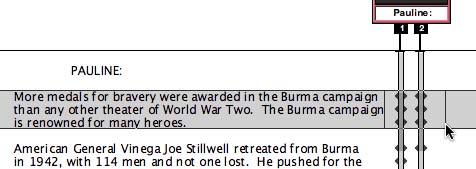Part 2: Editing Using ScriptSync in Avid Media Composer
Master ScriptSync, the amazing time-saver for any type of scripted project!
This is Part 2 of this tutorial series, where you’ll learn how to use ScriptSync. (Part 1 showed you how to set up your script in preparation for ScriptSync.)
Just a recap from Part 1: Scriptsync, an Avid Media Composer plug-in powered by Nexidia, is a terrific tool for scripted projects of any type—narrative, documentary, reality—basically anything that uses either a pre-planned script or an after-the-fact transcription. ScriptSync allows you to effortlessly and instantly sync all of your master clips to each line of your script. This tutorial will show you how!
Syncing your clips to the script with ScriptSync
Once you have properly imported your digital script (which we explored in Part 1), you’re ready to attach your master clips to the script, and then ultimately, sync the clips using ScriptSync.
Attaching your master clips to your script
Ok, it’s time to perform the only real “manual” labor of the ScriptSync process. You’ve got to match your master clips up to the portion of the script that they cover.
To sync your master clips to your script:
- Open the script, and open the bin that contains the master clips that match up with your script.
- Load your first clip into the Source Monitor and play it to see the lines that it covers. Your job is to identify where each clip will go on the script, since each clip must be placed on the equivalent lines within the script. Keep in mind, you may need to subclip the clip so that it covers an exact area of the script.
- When you’ve identified the location in the script that you’re going to begin working, highlight the lines by clicking and dragging the cursor through multiple lines (or by clicking the beginning line and Shift+clicking the last line of the covered dialog).

- Now, drag the corresponding clip or subclip (from the bin) onto the highlighted text within the Script window. (You’ve got to drop the clip fully within the highlighted portion, or it won’t work.) The slate will appear in the Script window, and a line will extend down through the duration of the previously highlighted lines.

- Repeat Steps 1-4 for every one of your master clips for the associated script.Note: you can drag several master clips to the script at once (just select multiple clips in the bin and drag them to the same expanse of the highlighted script.) You should do this for lines that all comprise different takes of the same performance.
Using ScriptSync
When you have all of your master clips attached to your script, you are ready to use ScriptSync, which matches the spoken word with the written word. Specifically, the “first word” of each line will be matched to the spoken dialog within the clip. It works much faster than real time, so long sections of your script will sync with your clips within seconds.
To use ScriptSync:
- Lasso the lines of dialog that you want to sync. Make sure that the take box underneath the slate is highlighted.
(If you select multiple takes—which you should do if the portion of your script includes many takes—just lasso the section of the script to include all associated take lines.) - Select Script > ScriptSync. The ScriptSync dialog box opens.

- Make your selections based on the following criteria:
.
• Language: choose which language you’re using. (Both the audio and text must be in the same language.)
• Tracks: Select which audio tracks you want to use to sync (i.e., if you interviewed with a lavalier on A1 and built-in camera mic on A2, check A1 only.)
• Skip lines that only contain CAPITAL letters: Since scripts often list speakers in all-CAPS, this is often a good option to exclude text.
• Skip text before colon: Scripts often place a character’s name before a colon, so this can be a good option to exclude text.
• Skip lines indented less than dialog: If your script contains action that is indented less than the dialog, then select this option, and click on the Select Dialog button. Then, select one line of dialog from the Script. The spaces are calculated automatically.
• Overwrite existing marks: If the script already contains script marks and you want to update the marks, select this option.
• Sync between first and last mark: If you want ScriptSync to be restricted to analyze only the script between the lines of text specified by the first and last script marks in a take, select this option. This is a good option to select if you have a big section of non-dialog talking that you don’t want to be marked. - Click OK. The scripting process starts.
- When ScriptSync finishes, your take(s) include(s) a script mark for every line of text.

Using the Synced Script to Edit
Now that you’ve synced your script, you’re ready for the magic to begin. Here are some tips for using your synced script:
To load your script mark(s):
- Double-click on a script mark to load the clip into the Source Monitor. This cues the clip to the synced line of dialog, and an IN point is placed at the sync location. Edit the clip into the Timeline per usual.
- If you want to play a longer selection of lines (that comprise multiple script marks), just lasso all the lines, and press the Play button in the Script window.

To load all the coverage for a range of lines:
- If you have multiple takes that comprise the same body of text in the script, you can lasso the script marks that include the lines you’d like to hear, and then play them back one after another in rapid succession. Simply select all included lines of dialog in the script, dragging through all intersecting takes (and through one or more script marks). This highlights all associated script lines and takes.

. - Click the Play button in the Script window to screen the takes for those lines. The takes load and play back one after another. You can use the Tab key or J-K-L keys to jump between takes and to control playback. This is a great way to quickly see all the performances of a given take.
To search for a particular word or phrase in your script:
- Click on the script and press Command+F (Mac) or Ctrl+F (Windows) to bring up the Find window. Type in your search criteria, and Avid Media Composer will find every instance of the text.
There’s a lot more about working with scripts that you’ll probably want to learn, such as how to manually add script marks (in case ScriptSync misses any), as well as how to add scene and page info, how to set offscreen dialog, and how to work most efficiently with slates. Be sure to check your Avid documentation for instructions on all of these topics.
Note: ScriptSync, which, for many years, was automatically included with Avid Media Composer, is now an optional component and must be purchased ($995) and installed separately (as of 5.5.1).
Here’s Avid, explaining why:“…Avid partners with a third-party company and licenses the underlying technology. Recently, our contract was renewed and due to increased licensing costs, we decided to offer ScriptSync as an option rather than pass the cost on to all of our customers. And it allows those who do take advantage of this technology to continue using it for an exceptional price.”
If you’d like to try a 30-day free trial of ScriptSync, you can!





